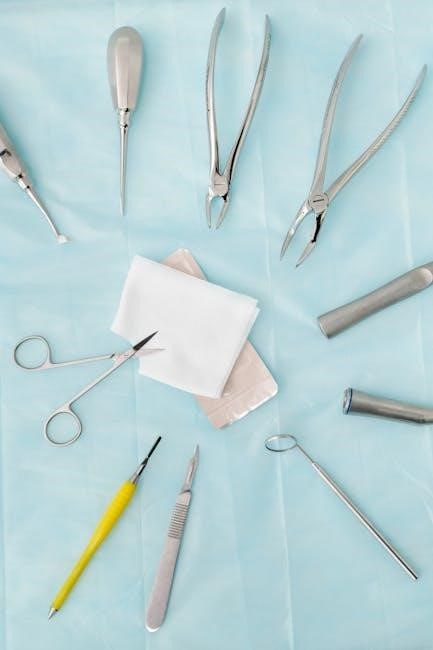Immediate Post-Operative Care (First 24 Hours)
Immediate post-operative care is crucial for healing. Bite on gauze for 30-60 minutes to control bleeding. Avoid spitting, rinsing, or using a straw for 24 hours. Rest with your head elevated to reduce bleeding. Do not smoke, drink alcohol, or consume carbonated beverages. Follow these steps to protect the surgical site and promote recovery.
1;1 Biting on Gauze
Bite firmly on the gauze for 30-60 minutes to control bleeding. Replace with a clean, damp gauze if bleeding continues. Avoid disturbing the site. Elevate your head to reduce bleeding. If active bleeding stops, remove the gauze. This step is essential for forming a protective blood clot, which aids healing and prevents complications.
1.2 Avoiding Spit, Rinse, or Suck
Do not spit, rinse, or use a straw for 24 hours. These actions can dislodge the blood clot, delaying healing or causing complications like dry socket. Avoid vigorous mouth movements or spitting to protect the surgical site and ensure proper recovery. This precaution is vital during the initial healing phase.
1.3 Restrictions on Smoking, Alcohol, and Carbonated Beverages
Avoid smoking, alcohol, and carbonated beverages for at least 24 hours. Smoking can delay healing and increase bleeding risk, while alcohol and carbonation may dislodge the blood clot, leading to complications like dry socket. These restrictions help protect the surgical site and ensure proper recovery during the critical initial healing phase.

Managing Bleeding After Extraction
Bleeding may continue for several hours. Bite on gauze for 30-60 minutes to control it. Rest quietly with your head elevated to minimize bleeding.
2.1 Duration and Normalization of Bleeding
Bleeding after extraction typically lasts several hours, with the heaviest flow in the first few hours. It usually diminishes gradually and stabilizes within 6-8 hours. Slight oozing may persist for up to 24 hours. Prolonged or heavy bleeding beyond this period is not normal and may require medical attention. Elevating the head and avoiding strenuous activities can help reduce bleeding.
2.2 Use of Gauze for Bleeding Control
To control bleeding, place a folded, damp gauze over the extraction site and bite firmly for 30-60 minutes. If bleeding persists, replace with fresh gauze for another 30 minutes. Avoid dislodging the blood clot, as it aids healing. Gently remove the gauze when bleeding stops. If bleeding continues, contact your dentist for further instructions to ensure proper wound management and prevent complications.
2.3 Signs of Excessive Bleeding
Excessive bleeding may occur if the blood clot is dislodged or not forming properly. Signs include soaking through multiple gauze pads within an hour, continuous bleeding despite gauze use, or visible blood clots in saliva. If bleeding persists or worsens, contact your dentist immediately. This is not normal and may require additional intervention to prevent complications and ensure proper healing.
Pain Management Strategies
Pain is normal after extraction. Manage it with prescribed or over-the-counter pain relievers as directed. Apply ice to reduce swelling and ease discomfort. Rest and avoid strenuous activities to promote healing and minimize pain.
3.1 Recommended Pain Relief Medications
Pain management is key for recovery. Use prescribed or over-the-counter pain relievers like ibuprofen or naproxen as directed. These medications reduce inflammation and alleviate discomfort. Avoid aspirin if instructed, as it may increase bleeding. Always follow dosage instructions and consult your dentist if pain persists or worsens. Proper use of pain medication ensures a smoother healing process.
3.2 Non-Medication Approaches
Non-medication methods can complement pain relief. Apply an ice pack to the cheek near the extraction site to reduce swelling. Eat soft, cool foods to avoid irritating the area. Rest and avoid strenuous activities to promote healing. Gently rinse with warm salt water after 24 hours to keep the site clean. These approaches support recovery without medication.
Dietary Recommendations
Stick to soft foods like yogurt, mashed potatoes, and scrambled eggs. Avoid hot, cold, or sharp foods. Opt for nutrient-rich options to support healing and recovery.
4.1 Soft Foods and Nutritional Advice
Opt for soft, nutrient-rich foods like yogurt, mashed potatoes, and scrambled eggs to minimize discomfort. Avoid sharp or crunchy foods that could disrupt the healing site. Stay hydrated with water or clear broths, and consider smoothies for essential vitamins. Choose bland, easily chewable options to support recovery while maintaining proper nutrition during the initial healing phase.
4.2 Avoiding Hot, Cold, or Sharp Foods
Avoid hot, cold, or sharp foods for 24-48 hours to prevent discomfort and healing interference. Hot foods can irritate the site, while cold foods may slow healing. Sharp or crunchy foods, like chips or crackers, can dislodge the blood clot or damage tissue. Opt for lukewarm, soft meals to protect the surgical area and ensure proper recovery.
Oral Hygiene Practices
Protect the surgical site by avoiding vigorous rinsing for 24 hours. After 24 hours, rinse with warm salt water 3-4 times daily. Brush gently around the area, avoiding direct contact with the extraction site to promote healing and prevent infection.
5.1 Rinsing with Warm Salt Water
Start rinsing with warm salt water 24 hours after surgery. Mix 1 teaspoon of salt in a glass of warm water. Rinse gently 3-4 times daily, especially after meals, to clean the area and reduce bacteria. Avoid vigorous rinsing to prevent dislodging the blood clot. This practice promotes healing and helps prevent infection.
5.2 Brushing Techniques
Resume gentle brushing 24 hours after surgery, avoiding the extraction site. Use a soft-bristled toothbrush and mild toothpaste. Brush other teeth normally to maintain oral hygiene. Avoid irritating the surgical area. For the first few days, consider using a child’s toothbrush for better control. This helps maintain cleanliness without disrupting the healing process.

Swelling and Bruising Management
Apply ice packs to the affected area to reduce swelling. Elevate your head while resting to minimize bruising. Monitor for signs of infection, such as increased redness or swelling.
6.1 Applying Ice for Swelling Reduction
Apply an ice pack or a cold compress to the swollen area for 15-20 minutes at a time, repeating every hour. This helps reduce swelling and bruising. Elevate your head while resting to further minimize swelling. Continue this process for the first 24-48 hours post-surgery to achieve optimal results and promote faster healing.
6.2 Monitoring for Infection Signs
Monitor for signs of infection such as fever, increased redness, swelling, pus, or worsening pain. Contact your dentist immediately if you experience any of these symptoms. Proper wound care and adherence to post-operative instructions can help prevent infection and ensure a smooth recovery.

Medications and Antibiotics
Take prescribed medications and antibiotics as directed by your dentist to manage pain and prevent infection. Follow dosage instructions carefully and complete the full course of antibiotics.
7.1 Importance of Prescribed Medications
Prescribed medications, including pain relievers and antibiotics, are essential for managing discomfort, reducing inflammation, and preventing infection. Adhering to the prescribed dosage and duration ensures proper healing and minimizes complications. Always follow your dentist’s instructions for medication use to achieve optimal recovery outcomes after your tooth extraction.
7.2 Potential Side Effects and Precautions
Certain medications may cause side effects like dizziness, nausea, or allergic reactions. Monitor for severe symptoms and consult your dentist immediately. Avoid overdosing or mixing medications with alcohol. Be cautious with antibiotics to prevent resistance. Adhere to prescribed instructions to minimize risks and ensure safe recovery after tooth extraction.
Follow-Up Care
Attend all scheduled post-operative appointments to monitor healing progress. Early detection of complications ensures timely intervention. Follow your dentist’s guidance for a smooth recovery.
8.1 Importance of Post-Operative Appointments
Post-operative appointments are essential for monitoring healing progress and ensuring proper recovery. Your dentist will assess the surgical site, remove sutures if needed, and address any concerns. Regular follow-ups help prevent complications and confirm that the healing process is on track. These visits are crucial for achieving optimal results and ensuring your comfort during recovery.
8.2 Recognizing Complications
Monitor for signs of complications, such as excessive bleeding, severe pain, swelling, fever, or redness. Pus, a foul odor, or uncontrolled bleeding may indicate infection. Difficulty breathing or rapid heartbeat are urgent concerns. Contact your dentist immediately if you experience any unusual symptoms, as early intervention is key to resolving potential issues and ensuring proper healing.

Long-Term Healing and Recovery
Gum healing typically takes 3-4 weeks, while bone healing may take 6-8 months. Proper care ensures complete tissue repair and prevents complications. Gradually resume normal activities, avoiding hard or sharp foods to protect the healing site.
9.1 Timeline for Gum and Bone Healing
Gum tissue typically heals within 3-4 weeks, while bone healing may take 6-8 months. Proper care, including avoiding sharp foods and smoking, supports recovery. The blood clot forms the foundation for healing, and protecting it ensures timely tissue repair. Adhering to post-operative instructions is crucial for preventing complications and achieving a smooth, uneventful recovery.
9.2 Resuming Normal Activities
Most patients can resume normal activities within 1-2 weeks, but full recovery may take 6-8 months. Avoid strenuous activities for 24 hours and gradually return to routine. Heavy lifting, bending, or exercise should be avoided for 2-3 days. Always follow your dentist’s advice for a safe and smooth transition back to daily life.
Emergency Situations and When to Seek Help
Seek immediate help if you experience excessive bleeding, severe pain, swelling, fever, or difficulty breathing. Contact your dentist right away for emergencies requiring prompt attention.
10.1 Identifying Red Flags
Monitor for heavy bleeding that doesn’t stop with gauze, severe pain, swelling that worsens, fever over 100.4°F, or difficulty breathing. These are signs of complications. Contact your dentist immediately if you experience any of these symptoms, as they may indicate infection, bleeding disorders, or other serious issues requiring urgent attention.
10.2 Contacting Your Dentist
Contact your dentist immediately if you experience heavy bleeding, severe pain, increased swelling, fever, or breathing difficulties. Provide details about your symptoms, medications, and any other concerns. Timely communication ensures proper evaluation and treatment, preventing complications and supporting a smooth recovery. Don’t hesitate to reach out for guidance or reassurance, as your dentist is there to help.

Leave a Reply